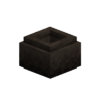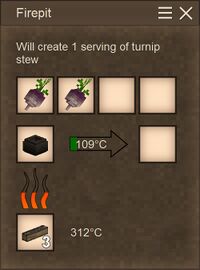Cooking pot
| Cooking pot | |

| |
| Material | Ceramic |
| Stackable | 1 |
| Drops | Itself |
| Blocks | |
The cooking pot is used to cook various meats, vegetables, grains, or fruit on a firepit and create meals. It is crafted from clay using the process of clay forming. Ingredients used in the cooking pot will increase the base satiety of the ingredients, and they must be added in a specific order for the cooking pot to work. To remove the contents in a cooking put, use a bowl on it to consume the meal, or pick up the cooking pot and throw it into water if the contents had rotted.
Obtaining
Cooking pots are created by clay forming. Cooking pots can be made from any type of clay. Raw unfired cooking pots must be fired in a pit kiln before use.
Usage
Cooking pots act as storage container with four slots, each holding up to 6 pieces of a food item or up to 6L of a liquid. Inedible items can also be placed in a cooking pot.
When placed on a firepit, the firepit interface will reflect the contents of the cooking pot. Ingredients can then be placed in the cooking pot in order to create a variety of meals. Once cooked, the meal must be removed using a bowl or a crock on the filled cooking pot. The bowl will "use up" one portion of the meal from the cooking pot.
Cleaning a cooking pot
If food rots inside a cooking pot, the resulting rot must be cleaned out before the cooking pot can be reused. This can be done by throwing the rot-filled cooking pot into a block of water and waiting a few seconds. The rot will float up while the now-empty pot will sink down.
Recipes
The first two slots, Slot 1 and Slot 2, determine the type of meal that will be created. Slot 3 and 4 are extra ingredients that can be added to boost the satiety of the meal, except jam which uses all 4 slots.
| Meal type | Slot 1 | Slot 2 | Optional |
|---|---|---|---|
| Meat stew | |||
| Vegetable Stew | |||
| Porridge | |||
| Soup | |||
| Scrambled eggs |
| Meal type | Slot 1 | Slot 2 | Slot 3 | Slot 4 |
|---|---|---|---|---|
| Jam |
Improved satiety of ingredients
Cooking ingredients in the cooking pot increases the satiety of the ingredient. The tables below list each ingredient's improved satiety, if they are used in a meal.
| Ingredient | Raw | Cooked | Improvement (%) |
|---|---|---|---|
| 80 | 120 | 50% | |
| 100 | 150 | 50% | |
| 300 | 450 | 50% | |
| 100 | 150 | 50% | |
| 100 | 120 | 20% | |
| 100 | 150 | 50% | |
| 100 | 150 | 50% | |
| 100 | 150 | 50% | |
| 140 | 180 | 29% | |
| 100 | 150 | 50% |
| Ingredient | Raw | Cooked | Improvement (%) |
|---|---|---|---|
| 30 | 120 | 300% | |
| 75 | 280 | 274% | |
| 60 | 240 | 300% | |
| 60 | 240 | 300% | |
| 60 | 240 | 300% | |
| 100[4] | 240 | 140% | |
| 60 | 240 | 300% |
| Ingredient | Raw | Cooked | Improvement (%) |
|---|---|---|---|
| 150 | 240 | 60% | |
| 280[5] | 420 | 50% | |
| 200 | 420 | 110% | |
| 200[6] | 375 | 88% | |
| 150 | 375 | 150% | |
| -[7] | 200 | - | |
| 220 | 375 | 70% | |
| 150 | 375 | 150% |
| Ingredient | Raw | Cooked | Improvement (%) |
|---|---|---|---|
| 80 | 120 | 50% | |
| 80 | 120 | 50% | |
| 200 | 250 | 25% | |
| 80 | 120 | 50% | |
| 40 | 60 | 50% | |
| 60 | 90 | 50% | |
| 60 | 80 | 33% | |
| 40 | 60 | 50% | |
| 80 | 120 | 50% | |
| 80 | 120 | 50% | |
| 80 | 120 | 50% | |
| 80 | 120 | 50% | |
| 80 | 120 | 50% | |
| 80 | 120 | 50% | |
| 80 | 120 | 50% | |
| 60 | 90 | 50% | |
| 80 | 120 | 50% |
| Ingredient | Raw | Cooked | Improvement (%) |
|---|---|---|---|
| 200 | 200 | 0% | |
| 240 | 240 | 0% |
Notes
- ↑ Mushrooms that are poisonous will apply their negative effects to the meal.
- ↑ Not currently obtainable in Vintage Story.
- ↑ Whole pumpkins cannot be used for cooking.
- ↑ Dried cassava cannot be eaten so the satiety value for the edible version is used.
- ↑ Raw redmeat cannot be eaten so the satiety value for the cooked version is used.
- ↑ Raw poultry cannot be eaten so the satiety value for the cooked version is used.
- ↑ Eggs cannot be eaten raw, and there are no other edible variants other than being cooked.
| Food and Cooking | |
|---|---|
| Finding food | Foraging • Farming • Animal husbandry • Cooking |
| Edibles | Fruit • Vegetable • Meat • Grain • Mushroom • Honey • Cheese |
| Meals | Vegetable stew • Meat stew • Soup • Porridge • Scambled eggs • Bread • Pie |
| Food preservation | Pickles • Cured meat • Jam • Cheese • Alcohol • Cellar |
| Cooking tools | Firepit • Clay oven • Cooking pot • Quern |
| Utensils | Bowl • Crock • Storage vessel |
| Other links | Room • Satiety |
| Wiki Navigation | |
|---|---|
| Vintage Story | Guides • Frequently Asked Questions • Soundtrack • Versions • Controls |
| Game systems | Crafting • Knapping • Clay forming • Smithing • Cooking • Temperature • Hunger • Mining • Temporal stability • Mechanical power • Trading • Farming • Animal husbandry |
| World | World generation • Biomes • Weather • Temporal storms |
| Items | Tools • Weapons • Armor • Clothing • Bags • Materials • Food |
| Blocks | Terrain • Plants • Decorative • Lighting • Functional • Ore |
| Entities | Hostile entities • Animals • NPCs • Players |
| Miscellaneous | List of client commands • List of server commands • Creative Starter Guide • Bot System • WorldEdit • Cinematic Camera • Adjustable FPS Video Recording • ServerBlockTicking |


